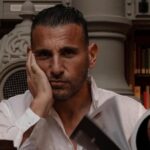Art has been around since the beginning of time, and though it has had many faces, the heart has always remained the same: to make the beholder feel. There is no denying the fact that art which evokes emotion is rare; however, the artists that create such masterpieces are even more so. Art is about resonating with people’s dormant emotions, whether good or bad.
We sat down with one such artist, a Cubism-abstract oil painter based in Los Angeles, who goes by the name of Tau. The artist’s love for astronomy, the universe, and spirituality led him to become a renowned painter. “When I’m painting, I’m not grounded by ideas. I want my work to represent me just as I am, even a hundred years from now,” Tau shared. Here’s an excerpt from his interview, where he shares his love for painting, art and much more.
When did you discover your passion for art?
That’s a whole story, actually. You see, I was born with a hearing problem, so I needed hearing aids, which was, in itself, a problematic experience. My condition made studying more challenging, so in my spare time, I used to sketch and draw whatever I was feeling at the moment. I liked that part of the day the most because that was the only time when there wasn’t anything expected of me; I was doing what I wanted.
There was also a time when I was 8, and I saw Oliver Stone’s movie Wall Street for the first time; there was a scene in which Picasso’s painting appeared. This was one of the most significant moments – where as a child, I was inspired to create, and I believe that was the moment when my passion for painting really arose.
Now that I think about it, it’s quite funny and ironic that the most materialistic and capitalist film of the time managed to give me inspiration for spirituality, art and creativity.
What made you choose Cubism-abstract over realism?
Ever since I was a child, I’ve always been different with very few friends, a lot of frustration, speech and sleep problems, and I wasn’t very good at communicating either. All this kind of made me an overthinker because I’d spend hours every day with my own thoughts. Even today, I’d say most of my works come from pain, excitement, and from being different from others.
I don’t like to call myself a tormented artist. The pain does not control me; I am simply aware of myself, aware of my motives, aware of my personal experiences. I studied myself and learned how to channel my experiences into my inner strength.
Most artists have role models, people they look up to. Do you have anyone like that?
My role model is mainly Picasso, although there are artists like Dali, Marc Chagall, Van Gogh and Paul Klee that I love just as much. But Picasso has a special place, his paintings, technique and confidence; there’s something magical in his work that can’t be explained.
I like to think that most of my work is influenced by Picasso, but in my childhood home, I also had a reproduction painting: Senecio, by Paul Klee, which also set me on a journey of learning about Paul Klee.
I just feel a weird connection with every artist who ever inspired me, and that’s something I cherish.
Art requires tremendous focus; how do you find the inspiration for it?
There’s actually a number of things that I do to keep my imagination fresh. I like trying new things, whether it’s reading a new book or trying a new hobby. I also watch old movies by Roman Polanski, Pedro Almodóvar and Federico Fellini. And my favorite one is Opposite Day. Especially on days when I don’t want to do something, I tell myself it’s Opposite Day, and I just go ahead and do it.
You must have faced difficulties in your life; how did you cope with the rough patches?
I don’t think like that. I believe that without these hurdles and challenges, life wouldn’t just be worth living. I mean, I did hit bottom more times than I can remember, but I never gave up on my dream. I think that’s what matters, not giving up.
















